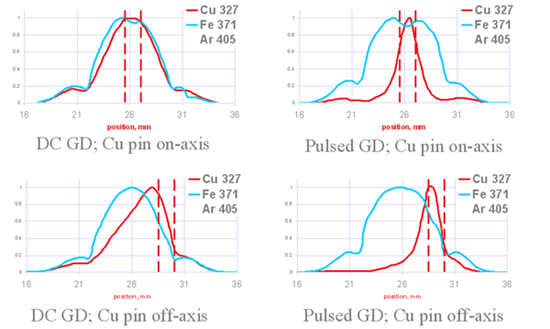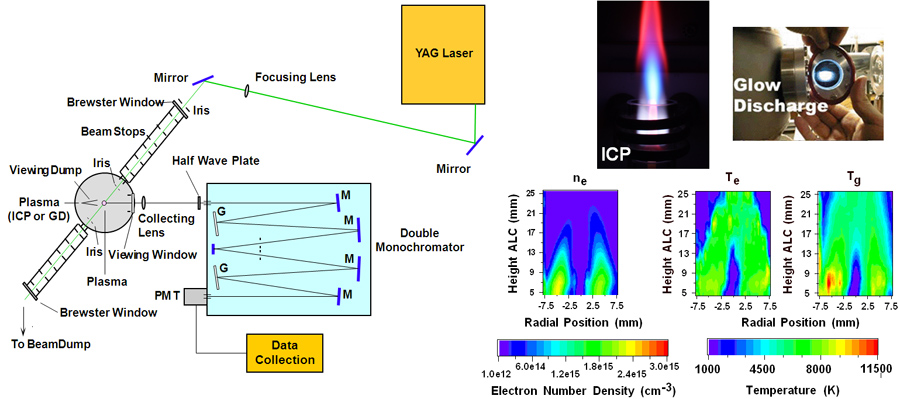Research: New Ideas and Instrumentation, Fundamental Plasma Studies, Molecular Analysis and Chemical Sensors, Elemental Mass Spectrometry Fundamental Plasma Studies |
|
|
|
|
Fundamental Mechanisms of Matrix Effects and Analyte Excitation in the Inductively Coupled Plasma Laser Scattering for Characterization of Plasma Fundamental Properties in the ICP and Glow Discharge Effect of a Mass Spectrometer Interface on the Fundamental Properties of the ICP Laterally Resolved Analyte Spatial Mapping With a Pulsed Glow Discharged |
|
|
|
|
|
|
|
|
|
|
|
One of the important remaining challenges with the ICP is the understanding
and elimination of matrix effects. An ICP spectrometer equipped with a 2-D
array detector that can simultaneously measure multiple emission lines from
an analyte can be used to deduce the matrix-effect mechanism. By monitoring
the change in emission intensity originating from different excitation
levels of the analyte while in the presence of a matrix, a picture of how
the matrix perturbs the analyte excitation levels can be obtained. This process can
lead to deduction of the fundamental mechanisms for a specific matrix
effect. Moreover, information on the excitation mechanism for a particular
energy level of the analyte can be obtained. |
|
| |
|
|
|
|
|
|
|
Plasmas (e.g. the inductively coupled plasma (ICP) and glow discharge (GD)) are important tools in elemental analysis. However, these devices still suffer from sample-related matrix effects, which affect analytical accuracy. An improved understanding of the plasmas could yield methods for the reduction of these effects. A 3-D picture of the plasma behavior can be developed by measuring, on a spatially resolved basis, the fundamental parameters of the discharge: the gas-kinetic temperature (Tg), electron temperature (Te), and electron number density (ne). We employ a number of techniques, all available in one instrument, to obtain this information. These techniques include Thomson scattering, Rayleigh scattering, laser-saturated atomic fluorescence, and computer-aided tomography.
|
|
|
|
|
Effect of a Mass Spectrometer Interface on the Fundamental Properties of the ICP
|
|
 |
|
|
The inductively coupled plasma (ICP) has become an important source for atomic mass spectrometry (ICP-MS). Like many techniques, ICP-MS suffers from matrix interferences. Although most of the work to date has focused on the mass spectrometer, the ICP itself also suffers from matrix effects and might contribute to the observed ICP-MS interferences. To study matrix effects in the plasma, a mass spectrometer interface has been coupled to the ICP. This setup allows optical monitoring of fundamental plasma parameters to determine if these properties are changed by the presence of the interface. |
|
|
Laterally Resolved Analyte Spatial Mapping With a Pulsed Glow Discharge
|
|
 |
 |
|
Although glow discharge optical emission spectrometry (GD-OES) can compete in many ways with other techniques for surface analysis, it does not, under typical conditions, give any information about the lateral (in the plane of the surface) variations in surface composition. It has been shown, however, that in an otherwise homogeneous sample, some information about the location of plug of a second material embedded in the sample can be acquired by scanning across the sample surface and analyzing the intensity distribution of the line emission from the two materials. The peak intensity of the minority material signal is found above its location on the sample, at the same location as a dip in the intensity of the majority material signal. Preliminary results show that using short pulses yields better lateral resolution. Factors affecting the lateral resolution are currently being studied and methods for three-dimensional determination of metals are being devised.
|
|



